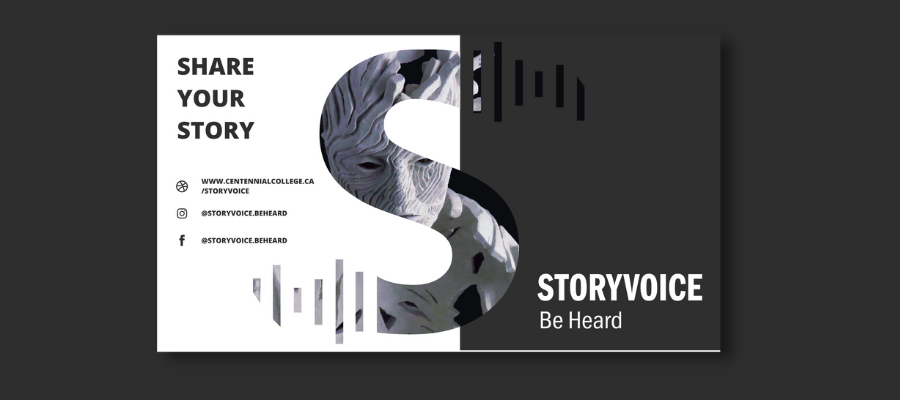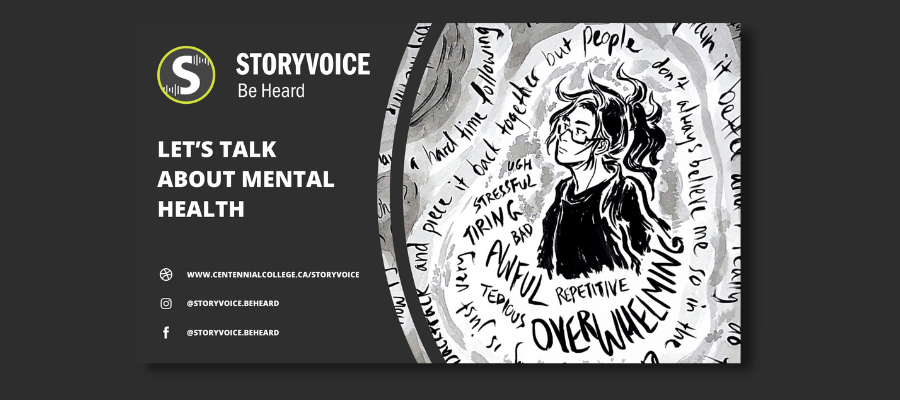Visual art and written communication combine in the latest project launched by the College – Storyvoice. Centred on sharing stories about mental health, this project allows contributors to express their experiences about their personal mental health journey and tie it into a piece of art.
Anthony Harrison, Fine Arts Studio Instructor and Project Lead on Storyvoice, shares, “I have been an instructor at Centennial College in Fine Arts Studio for 16 years and I have seen that students who are experiencing common mental health issues, such as anxiety or depression, will often suffer in silence and not seek help. Part of this is that there is a stigma around these issues in society in general.”
He continues, “My idea for Storyvoice was to create a platform that could tell students stories with art to create more dialogue on the issue, as well as provide students with more information about supports available from the College. As Project Lead, I conceived of the project, selected the team members, gave direction, and—very importantly, with any team—listened to them, and they have just done fabulous work. The most exciting part has been to receive the absolutely moving and beautiful artwork from Centennial students and alumni.”
Anthony adds that this project can be described as a visual dialogue on mental health. “The primary quality that it has is that it’s telling, through art, the life experience of people who have struggled with some form of mental health issue. Those beautiful pieces of art are accompanied by artist statements, so there is text as well.”
Storyvoice generates important and needed discussions on mental health, which Anthony says is one of the most important things when it comes to dealing with stigma. With each piece of art is an artist statement, which, he explains, directly addresses the artist's personal experience.
“When issues are not communicated, then they get worse. It’s not just that they’re not being dealt with. They get worse because, with any issue, it becomes more difficult to deal with if you hold it in. With mental health, I would go so far as to say it amplifies a mental health issue, not to discuss it. So, what we are achieving with Storyvoice is that we are hosting this dialogue,” he explains.

The name Storyvoice was selected largely because of the nature of the project itself. Anthony wanted the name to help communicate that there are stories to tell, and because of his background in teaching at the Story Arts Centre campus, had the idea to tie in the project’s name within that component as well. “Most importantly, though, is that the student works are telling a story and that this platform, as part of the greater Centennial site, is providing a means for their voices to be heard,” he adds.
Adding the artist statement that coincides with the art piece within each submission plays a significant role in helping to communicate the message behind the art. Anthony says that supplying this written background to the work is very important because pieces of art need to affect the viewer in a variety of ways. Because of this, there can sometimes be ambivalence within an image.
“You might see it and think, ‘Oh, that’s so lovely,’ and you may not have really heard, if I can put it in those terms, all of what the artist is saying. The artist's statement will clarify aspects of their work. The work ultimately does need to stand on its own as a piece of aesthetic art. Still, the artist statement allows for the subtlety of the artwork to remain subtle and for greater clarity of the message to be available,” he says.
Producing a message through both written and visual mediums and sharing insight into deeply personal stories within this project helps showcase how art and mental health/wellness intersect and how art can be a beneficial tool for many to turn to.
Anthony explains, “The practice of producing art is in itself tremendously therapeutic. You are translating your life experience and your observations into something external from yourself. You are drawing from yourself outwards and condensing it into a visual expression or another form of art—music, film, photography, sculpture, etc. These are all artistic forms that draw from the individual, just as they are drawing from life. I find that my mood is greatly elevated through the production of artwork, and I can see in myself that if I’m not drawing enough, I start to get too intense.”

Anthony adds, “I would just like to thank all of our contributors for their wonderful artwork and equally strong artist statements. I’d also like to thank our team, Centennial College and specifically ARIF as well for supporting us in this and allowing this to happen. Lastly, thank you for reaching out to me and by helping to get our message out.”
If you are interested in contributing to Storyvoice, Anthony says visiting the project’s website is a contribution in and of itself. He also encourages everyone to sign up for their newsletter and share their website and social media links. To discuss the project and/or submit your work, you can email: storyvoice.info@gmail.com
You can find out more about Storyvoice and see some submissions on their Instagram and Facebook pages.
Article by: Alexandra Few
Check out and subscribe to our Storyteller newsletter to read all the other great stories happening in and around the Story Arts Centre.
